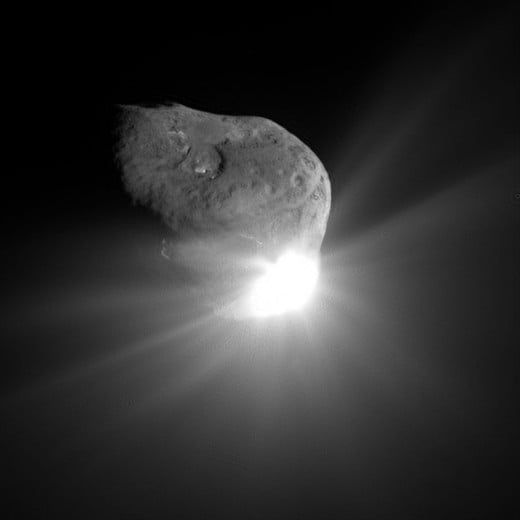What Are Some Famous Space Collisions?

It may not come as a shock to many of you reading this, but space collisions are a critical phase of our solar system’s history. Really. As our neighborhood formed, objects were constantly colliding and through those interactions every collision gave and took away energy. Eventually, collisions lead to accretion of he building blocks of the solar system and thus planets and moons formed. Asteroids and comets were also created in these early years. But just because all has settled down does not mean that we are out of danger currently. Everyday 100’s of tons of space material enters out atmosphere and both asteroids and comets continue to pose threats to our existence (Tyson 45-6). So with these more common occurrences in mind, what exceptions exist? Plenty.

Theia
Around 4.5 billion years ago, a Mars-sized object called Theia collided with Earth. It was just a glancing blow. But it was enough to make the surface of the Earth molten and knock off a huge chunk of it while the core of Theia sunk into Earth. This bit that broke off would eventually solidify and become the Moon. Yes, a brief story but an important one in our history. But it was not the only collisional event the moon has been involved in.

Late Heavy Bombardment Period
About 500 million years after Theia brought destruction to Earth and the Moon formed, it underwent a huge series of collisions for reasons that are still unclear. The most likely reason is one supplied by the Nice model of the solar system’s formation. According to it, gravitational perturbations from Jupiter and Saturn interactions caused Uranus and Neptune to switch places and bring material from the Kuiper Belt towards the inner system. The Moon, being a large object around us with a gravity field, caused many of the objects to be drawn to it. We still see the scars of that event to this day. All those craters we can see from Earth with the naked eye likely formed during this chaotic period.

LCROSS
Of course, comets and asteroids have not been the only objects to hit the Moon. Man has made sure to launch objects to crash into the Moon so that data could be collected about it. On October 9, 2009 the Lunar Crater Observation and Sensing Satellite (LCROSS) fired what was essentially a missile into the Moon crater called Cabeus: the 2.2-ton upper stage of a Centaur rocket. A few minutes later LCROSS itself crashed into the crater at 5,600 miles-per-hour as it analyzed the chemical composition of the plume the rocket created. So why was this done? In an effort to measure water content on the Moon, which was confirmed thanks to this mission (Chang).

Deep Impact
Before LCROSS, another impact mission was assigned to further our understanding of the solar system. But the target was not the Moon but instead a comet called Tempel 1. On July 5, 2005 the Deep Impact probe fired a small projectile into the comet in an attempt to understand the composition of it. The plume that resulted was bright and more magnificent than scientists initially though it would be, largely due to more reflective dust than previously hypothesized.

Shoemaker-Levy 9
Comets were a source of another interesting space collision. Long-period comets, which take over 10,000 years to complete one orbit around the Sun, can achieve speeds of 100,000 miles-per-hour and faster. (Tyson 46). Since E = ½mv2 (energy equals one half mass times speed squared), the amount of potential destruction is high. In 1994 scientists got the chance to witness this destructive capability when the recently discovered Shoemaker-Levy 9 broke up as it approached Jupiter and collided with it in the southern hemisphere. The scars of that impact lingered for weeks and telescopes captured it all. Never before had a collision on another planet been seen, much less recorded in such detail.
Satellite Collisions
Sometimes those instruments that we use to see such events have problems of their own. In February of 2009 an accidental collision occurred between a 1234-pound U.S. Iridium satellite and a 1984-pound Russian Cosmos 2251 satellite over Siberia at an altitude of 490 miles up (Iannotta). Of course at the speeds these crafts were going, they were obliterated Almost 4 years later on January 22, 2013 a 16.5-pound Russian Ball Lens in the Space (BLITS) satellite collided with China’s Fengyun 1C, which had been demolished earlier in its life once its mission had ended. The piece BLITS hit may have just been an eighth of a pound in size. With over 500,000 objects bigger than a marble orbiting up there, more collisions are surely on their way (“Russian”).
Works Cited
Chang, Kenneth. “Water Found on Moon, Researchers Say.” New York Times. New York Times, 13 Nov. 2009. Web. 5 Oct. 2014.
Iannotta, Becky; Tariq Malik. “U.S. Satellite Destroyed in Space Collision.” Space.com. N.p., 11 Feb. 2009. Web. 6 Oct. 2014.
“Russian satellite hit by ‘space junk’ from destroyed Chinese spacecraft.” RT.com. N.p., 9 Mar. 2013. Web. 6 Oct. 2014.
Tyson, Niel DeGrasse. Space Chronicles. Ed by Avis Lang. Norton Publishing, 2009: 45-6. Print. May 13, 2014.
- Why Did We Never Go Back To The Moon?
Looking up at the sky, it seems so close and within easy reach. Man has landed there 6 times, and then never again. Why? - What Have We Brought Back From Space?
We know of many missions sent into space, but what about those special ones that came back with something from outer space?
© 2014 Leonard Kelley







